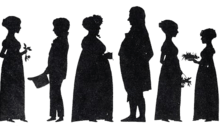Eastern Norwegian patriciate

.png)

The Eastern Norwegian patriciate was a social class, referred to as patricians, from the 17th century until around 1830–1840. While not a legally defined class as such (although the in towns residing burghership existed as a legally privileged group), the term was used by contemporaries and is used by historians to denote the leading mercantile families, i.e. the upper level of the bourgeoisie.
History
The patriciate was a small group of families, especially in the cities of Eastern Norway, and many of them based their wealth on timber trade and shipping. Some patrician families also were major land owners. Together with the higher civil servants and clergy, but below the nobility, patricians constituted the leading non-noble class in the kingdom in an era that lasted until some years after the Napoleonic Wars. A number of patrician families were themselves, per purchase, raised to the Dano-Norwegian nobility in the 18th and 19th centuries.
The patriciate is often referred to by city, for example as the Christiania Patriciate, the Skien Patriciate and so forth. These were usually small circles of related families who played a dominant role in the cities and their surrounding areas.
In a letter to Georg Brandes from 1882, playwright Henrik Ibsen gave an example of patrician families dominating his native Skien when he grew up there, mentioning the families Paus, Plesner, von der Lippe, Cappelen and Blom.[1] The families Aall, Collett, Løvenskiold, Anker and Treschow were also considered part of the patriciate. The Løvenskiold, Anker and Treschow families received Dano-Norwegian noble status in 1739, 1778 and 1812, respectively. Christopher Paus of the Paus family was created a count by the Pope in 1923.
In the 18th and 19th centuries, patrician families in Norway were often vastly more wealthy than most families with formal nobility, which in the late years of Denmark-Norway had mostly become a distinction bestowed on military officials and civil servants. However, the nobility was legally and socially superior in exclusivity and rank, as specified by royal decrees, and (purchased) noble status was for many patricians of the 18th century the ultimate object to acquire. Individuals of the nobility sometimes chose to marry patricians, and e.g. the Counts of Wedel-Jarlsberg descend from several patrician families, among them Anker and Tank.
Following the Napoleonic Wars, many of the patrician families struggled financially, and a new mercantile class emerged in the 1830s–1840s.[2]
List of patrician families (selection)
See also
- Norwegian nobility
- Patrician (post-Roman Europe)
- Bildungsbürgertum
- Habitus (sociology)
- Symbolic capital
- Social environment
References
- ↑ http://www.dokpro.uio.no/litteratur/ibsen/hi17.txt
- ↑ Egil Børre Johnsen, Trond Berg Eriksen, Norsk litteraturhistorie: 1750-1920, Universitetsforlaget, 1998, s. 322
Literature
- John Peter Collett and Bård Frydenlund (eds.), Christianias handelspatrisiat: En elite i 1700-tallets Norge, Andresen & Butenschøn, 2008, ISBN 82-7694-220-2